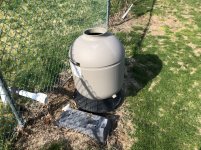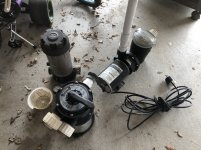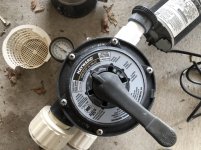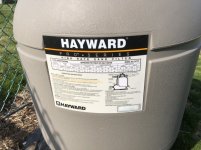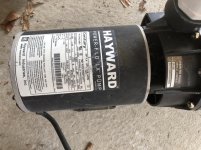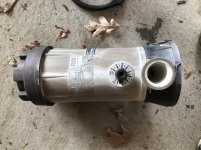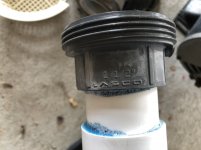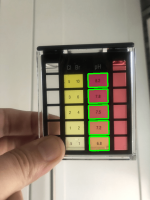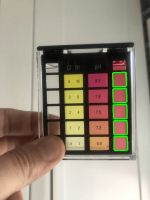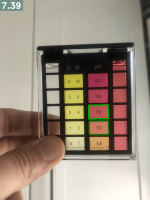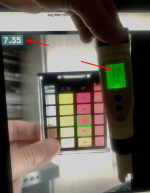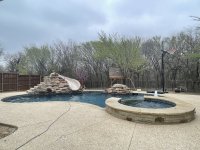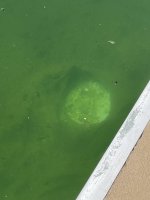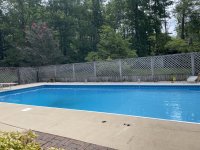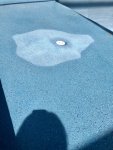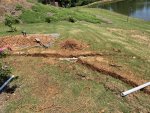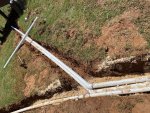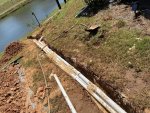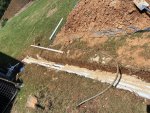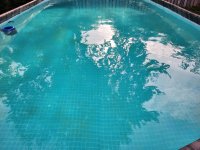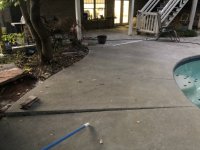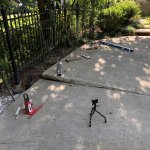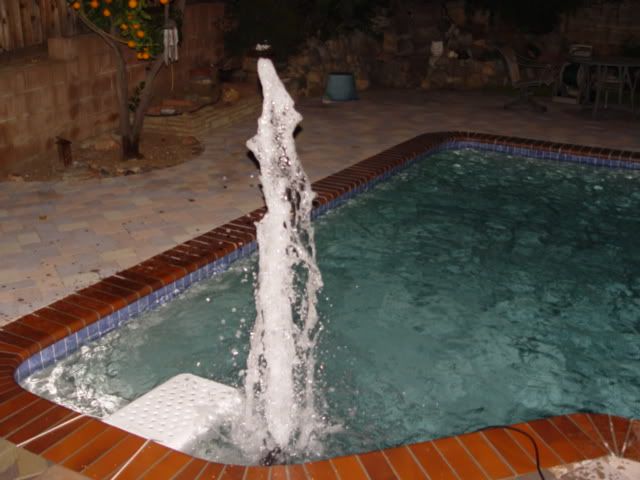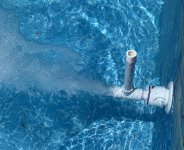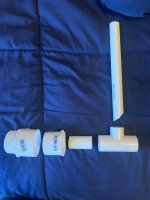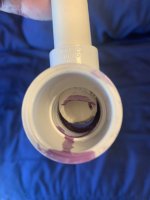WARNING: This post is bound to be controversial.
I know that we generally tell people to shock their pools with chlorine if they have algae and we tell them to dilute the water to lower high Cyanuric Acid (CYA) levels first before doing such shocking. However, there are some cases where there might be more expedient approaches that would be worthwhile. Specifically, if one gets yellow/mustard algae then higher CYA levels make the required chlorine levels quite high for getting rid of such algae. If one has a saltwater chlorine generator (SWG) pool where a higher CYA level is usually recommended or if one is in a very sunny area without a pool cover and has a higher CYA level to reduce chlorine loss, then fighting yellow/mustard algae with chlorine alone can become impractical or certainly cumbersome and no longer inexpensive. Also, there may be times when one has very high CYA levels but is unable or unwilling to dilute their water right away yet wants to clear their pool of algae.
So what can one do to fight algae other than using chlorine? We've all gone over the various alternatives before, but this time let's see if there is a lesser evil in terms of side effects. Some of this discussion would also be applicable to those who'd rather use Trichlor as a primary source of chlorine (presumably for convenience) and not worry much about the CYA level.
Copper -- this is one of the only algicides (other than chlorine itself) that will kill existing algae in addition to being able to prevent its growth. The downside, of course, is staining and greenish tinted hair if the copper levels or the pH (or sometimes TA) get too high. Copper is also persistent so this isn't a great candidate for a get-in-then-get-out approach. It would be great if one knew the copper levels needed for algae prevention or killing and the levels of pH and TA that can cause the copper to precipitate. The
Taylor K-1730 will test for copper, but without knowing the "problem" levels, this is a risky approach.
Bromine -- this is usually created by adding sodium bromide into the pool that already has chlorine in it. Since the bromine doesn't bind to CYA, it is full-strength even at high CYA levels and can kill and oxidize algae. The downside is that one ends up with a bromine pool with a higher chlorine demand as bromine breaks down in sunlight than chlorine in a pool with CYA (bromine breaks down from sunlight more slowly than chlorine if there is no CYA present). Eventually, over weeks (or longer), the bromine dissipates if the levels aren't too high (does it outgas? does it combine with organics and get caught in the filter and then backwashed?)
Monochloramine -- this is usually created by adding an ammonium compound (or one could use ammonia itself) into the pool that already has chlorine in it. Monochloramine doesn't bind to CYA so is at full-strength even at high CYA levels. Though not as strong an oxidizer as chlorine, monochloramine looks similar to ammonia that most algae desire as a source of nitrogen. Once taken in, the monochloramine apparently disrupts algae growth.
Phosphate removers -- this is usually lanthanum chloride which ultimately precipitates the phosphate out as lanthanum phosphate. The main side effect is cloudy water from lanthanum carbonate that is eventually filtered out and replaced with lanthanum phosphate. The phosphate level must be brought down to very low levels below around 125 ppb in order to prevent most algae growth. This product is not very effective in killing existing algae since it is not an oxidizer and any oxidation of algae by chlorine will tend to break up the algae releasing phosphates back into the water. So a phosphate remover is best used as an algae preventative though could slow down an existing bloom if sufficient doses were used to account for the additional phosphates released from oxidized algae. The
Taylor K-1106 will test for phosphate level.
PolyQuat 60 -- this prevents algae growth through rather slow mechanisms so isn't very good at killing existing algae. It must also be added weekly since it breaks down from chlorine and is also a clarifier so can get filtered out. It is not absolute and probably can only protect a pool from green algae growth up to around 200-250 ppm CYA (at around 3 ppm FC). I don't know how it does against yellow/mustard algae.
Borates -- this inhibits algae growth so is not suitable to add to try and kill existing algae. It is persistent and a pH buffer and the only apparent side effect is an increased toxicity of the water, mostly for animals (e.g. dogs) drinking cups of water every day from the pool. It may be rather weak so would take the edge off of algae growth but would not completely prevent it under extreme conditions. I also don't know how it does against yellow/mustard algae in terms of inhibition.
Other methods -- am I leaving anything out?
The questions are 1) what is the best approach to killing yellow/mustard algae if one generally wants/needs a higher CYA level? and 2) what is the best approach to preventing yellow/mustard algae from returning if one does not want to maintain the higher FC that is 15% of the CYA level that is known to prevent such growth (say, when such algae is regularly re-introduced)?
For an existing yellow/mustard algae outbreak, looking at the above list it seems that intentionally creating monochloramine through addition of an ammonium product (or ammonia) carefully dosed would create a temporary, though possibly smelly (depending on dose), situation to kill algae in spite of a high CYA level. After the algae has been killed, the monochloramine can rather easily be removed through oxidation by additional chlorine. This meets the criteria of "get-in-get-out" and would allow one to keep the higher CYA level without dilution of the water. The main problem is that I don't know the proper level of monochloramine needed to kill algae nor how long it would take. Some level of shocking with chlorine would also be needed to more fully oxidize the algae itself if it were not filtered out or vacuumed up (perhaps with the aid of a flocculant if one is impatient or where circulation is poor).
For prevention of algae, especially in pools where it is difficult to completely kill yellow/mustard algae or where such algae is frequently reintroduced into the water, then one wants a persistent algicide. In this situation, it looks like borates might be the best bet except I don't know how effective it is against yellow/mustard algae and the level of chlorine one can then use to prevent its growth. PolyQuat 60 used weekly might work but as noted it must be added weekly without fail. Phosphate removers would very likely work and after the initial large expensive dose to remove higher phosphate levels, it's mostly a maintenance dose to get rid of phosphates introduced from fill water or blown-in fertilized soil. If we could figure out the right levels of copper and proper control of pH (perhaps even using borates to help prevent pH rise) then that could work but as noted would be risky (and expensive to fix) if copper levels or pH got too high.
When it comes to those pool owners who prefer the convenience of Trichlor over manual regular dosing of chlorinating liquid or bleach, it used to be that an algicide added weekly such as PolyQuat 60 would be part of "no algae, guaranteed" programs. These days, it seems that phosphate removers are promoted instead. Some Trichlor pucks have copper in them with such copper being the algicide. At least with Trichlor, it is likely for the pH to be on the low side which would reduce the risk of staining, but without copper testing and not knowing limits, this is risky.
Richard





